Identification, Characterization, and Chemical Management of Fusarium asiaticum Causing Soybean Root Rot in Northeast China
Abstract
:1. Introduction
2. Materials and Methods
2.1. Pathogen Isolation and Assessment of Their Pathogenicity
2.2. Identification of the Pathogen
2.3. Biological Characteristics of Fusarium asiaticum
2.4. Host Range Determination of Fusarium asiaticum
2.5. Sensitivity of Fusarium asiaticum to Fungicides
2.6. Efficacy of Pyraclostrobine and Fludioxonil Against Soybean Root Rot Caused by Fusarium asiaticum
2.7. Data Analysis
3. Results
3.1. Disease Symptoms and Identification of Causal Organisms
3.2. Pathogenicity of Fusarium asiaticum on Soybean Roots
3.3. Biological Characteristics of Fusarium asiaticum
3.4. Host Range Determination of Fusarium asiaticum
3.5. Sensitivity to Fungicides
3.6. Efficacy of Fungicides on Soybean Root Rot Caused by Fusarium asiaticum
4. Discussion
5. Conclusions
Author Contributions
Funding
Data Availability Statement
Conflicts of Interest
Appendix A
| Strains | ITS Regions | TEF Gene | GPD Gene |
|---|---|---|---|
| Fusarium asiaticum HL9 | OQ061210.1 | OQ378361.1 | OQ378358.1 |
| F. asiaticum HL15 | OQ061466.1 | OQ378360.1 | OQ378363.1 |
| F. asiaticum HL25 | OQ061472.1 | OQ378362.1 | OQ378359.1 |
| F. asiaticum HL35 | OM967192.1 | ON011079.1 | ON011080.1 |
| F. asiaticum | OM100564.1 | LC500693.1 | KM062027.1 |
| F. oxysporum | MH221085.1 | KY123890.1 | LC592361.1 |
| F. subglutinans | KY318486.1 | KF467375.1 | OK000516.1 |
| F. verticillioides | KX385055.1 | KF467376.1 | OK000520.1 |
| F. mundagurra | MZ379241.1 | MZ399212.1 | MZ399215.1 |
| F. verrucosum | KM231812.1 | KM231940.1 | KM232077.1 |
| F. proliferatum | GU074010.1 | KF467371.1 | GU338455.1 |
| F. sambucinum | DQ132833.1 | KM231941.1 | KF896804.1 |
| F. illudens | KM231806.1 | KM231934.1 | KM232068.1 |
| F. graminearum | JX162395.1 | MW620072.1 | OM048104.1 |
| Alternaria alternata | MK351431.1 | MT178330.1 | MN607983.1 |
References
- Patil, G.; Vuong, T.D.; Kale, S.; Valliyodan, B.; Deshmukh, R.; Zhu, C.S.; Wu, X.L.; Bai, Y.H.; Yungbluth, D.; Lu, F.; et al. Dissecting genomic hotspots underlying seed protein, oil, and sucrose content in an interspecific mapping population of soybean using high-density linkage mapping. Plant Biotechnol. J. 2018, 16, 1939–1953. [Google Scholar] [CrossRef]
- Tan, Z.Y.; Kang, Z.; Huang, H.N.; Chen, H.B.; Gong, G.S.; Yong, T.W.; Yang, W.; Chang, X.L. Development of 8% uniconzole·propiconazole·abamectin suspension seed coating agent and its control effect against Fusarium root rot of soybean. J. Nucl. Agric. 2020, 34, 954–962. [Google Scholar]
- Li, Y.G.; Zhao, T.X.; Khuong Gia, H.H.; Xu, L.K.; Liu, J.X.; Li, S.X.; Huang, H.W.; Ji, P.S. Pathogenicity and genetic diversity of Fusarium oxysporum causing soybean root rot in northeast China. J. Agric. Sci. 2018, 10, 13–24. [Google Scholar] [CrossRef]
- Li, N.N.; Zhou, Q.X.; Chang, K.F.; Yu, H.T.; Hwang, S.F.; Conner, R.L.; Strelkov, S.E.; McLaren, D.L.; Turnbull, G.D. Occurrence, pathogenicity and species identification of Pythium causing root rot of soybean in Alberta and Manitoba, Canada. Crop Prot. 2019, 118, 36–43. [Google Scholar] [CrossRef]
- Roth, M.G.; Webster, R.W.; Mueller, D.S.; Chilvers, M.I.; Faske, T.R.; Mathew, F.M.; Bradley, C.A.; Damicone, J.P.; Kabbage, M.; Smith, D.L. Integrated management of important soybean pathogens of the United States in changing climate. J. Integr. Pest. Manag. 2020, 11, 17. [Google Scholar] [CrossRef]
- Han, S.Y.; Chen, J.X.; Zhao, Y.J.; Cai, H.S.; Guo, C.H. Bacillus subtilis HSY21 can reduce soybean root rot and inhibit the expression of genes related to the pathogenicity of Fusarium oxysporum. Pestic. Biochem. Phys. 2021, 178, 104916. [Google Scholar] [CrossRef] [PubMed]
- Xue, A.G.; Cober, E.; Voldeng, H.D.; Cober, E.; Voldeng, H.D.; Babcock, C.; Clear, R.M. Different aggressiveness in isolates of Fusarium graminearum and Fusarium pseudograminearum causing root rot of soybean. Can. J. Plant Pathol. 2006, 28, 369. [Google Scholar]
- Chang, K.F.; Hwang, S.F.; Conner, R.L.; Ahmed, H.U.; Zhou, Q.; Turnbull, G.D.; Strelkov, S.E.; McLaren, D.L.; Gossen, B.D. First report of Fusarium proliferatum causing root rot in soybean (Glycine max L.) in Canada. Crop Prot. 2015, 67, 52–58. [Google Scholar] [CrossRef]
- Abdelmagid, A.; Hafez, M.; Soliman, A.; Adam, L.R.; Daayfe, F. First report of Fusarium sporotrichioides causing root rot of soybean in Canada and detection of the pathogen in host tissues by PCR. Can. J. Plant Pathol. 2021, 43, 527–536. [Google Scholar] [CrossRef]
- Detranaltes, C.; Jones, C.R.; Cai, G. First report of Fusarium fujikuroi causing root rot and seedling elongation of soybean in Indiana. Plant Dis. 2021, 105, 3762. [Google Scholar] [CrossRef]
- Naeem, M.; Munir, M.; Li, H.J.; Ali Raza, M.; Song, C.; Wu, X.L.; Irshad, G.; Bin Khalid, M.H.; Yang, W.Y.; Chang, X.L. Transcriptiona1 responses of Fusarium graminearum interacted with soybean to cause root rot. J. Fungi. 2021, 7, 422. [Google Scholar] [CrossRef] [PubMed]
- Jang, Y.; Yi, H.; Maharjan, R.; Jeong, M.; Yoon, Y. First report of root rot caused by Fusarium armeniacum on soybean in Korea. Plant Dis. 2022, 106, 1306. [Google Scholar] [CrossRef] [PubMed]
- Detranaltes, C.; Saldanha, M.; Scofield Steven, R.; Cai, G.H. First report of Fusarium commune causing root rot of soybean seedlings in Indiana. Plant Dis. 2022, 106, 3216. [Google Scholar] [CrossRef] [PubMed]
- Yan, H.; Nelson Jr, B. Effects of soil type, temperature and moisture on development of Fusarium root rot of soybean by Fusarium solani (FSSC 11) and Fusarium tricinctum. Plant Dis. 2022, 106, 2974–2983. [Google Scholar] [CrossRef] [PubMed]
- Chang, X.L.; Yan, L.; Naeem, M.; Khaskheli, M.I.; Zhang, H.; Gong, G.S.; Zhang, M.; Song, C.; Yang, W.Y.; Liu, T.G.; et al. Maize/Soybean relay strip intercropping reduces the occurrence of Fusarium root rot and changes the diversity of the pathogenic Fusarium species. Pathogens 2020, 9, 211. [Google Scholar] [CrossRef] [PubMed]
- Lerch, E.; Arritt, N.; Dorrance, A.E.; Robertson, A.E. Quantitative Trait Loci (QTL) conferring resistance in soybean to root rot caused by Pythium oopapillum. In Proceedings of the 2017 APS Annual Meeting, San Antonio, TX, USA, 5–9 August 2017. [Google Scholar]
- Grijalba, P.E.; Ridao, A.D.; Steciow, M. Damping off on soybean (Glycine max) caused by Pythium aphanidermatum in Buenos Aires Province (Argentina). Rev. Fac. Cienc. Agrar. 2020, 52, 282–288. [Google Scholar]
- Kumar, S.; Rajput, L.S.; Ramteke, R.; Nataraj, V.; Ratnaparkhe, M.B.; Maheshwari, H.S.; Shivakumar, M. First report of root rot and damping-off disease in soybean (Glycine max) caused by Pythium deliense in India. Plant Dis. 2021, 105, 2022. [Google Scholar] [CrossRef]
- Liu, B.; Shen, W.S.; Wei, H.; Smith, H.; Louws, F.J.; Steadman, J.R.; Correl, J.C. Rhizoctonia communities in soybean fields and their relation with other microbes and nematode communities. Eur. J. Plant Pathol. 2016, 144, 671–686. [Google Scholar] [CrossRef]
- Shehata, M.A.; Pflege, F.L.; Davis, D.W. Response of susceptible and moderately resistant pea genotypes to interaction between rhizoctonia and three other stem and root rot pathogens. Plant Dis. 1983, 67, 1146–1148. [Google Scholar] [CrossRef]
- Anderson, T.R. Fungi isolated from stems and roots of soybean in Ontario. Can. Plant Dis. Sur. 1987, 67, 3–5. [Google Scholar]
- Li, S.; Hartman, G.L. First report of Stachybotrys chartarum causing soybean root rot. Plant Dis. 2000, 84, 100. [Google Scholar] [CrossRef] [PubMed]
- Susilowati, A.; Wahyudi, A.T.; Lestari, Y.; Suwanto, A.; Wiyono, S. Potential Pseudomonas isolated from soybean rhizosphere as biocontrol against soilborne phytopathogenic fungi. Hayati J. Biosci. 2011, 18, 51–56. [Google Scholar] [CrossRef]
- Detranaltes, C.; Cai, G. First report of Mycoleptodiscus terrestris causing root rot of soybean in Indiana. Plant Dis. 2020, 105, 1194. [Google Scholar] [CrossRef] [PubMed]
- Mattupalli, C.; Cuenca, F.P.; Shiller, J.B.; Watkins, T.; Hansen, K.; Garzon, C.D.; Marek, S.M.; Young, C.A. Genetic diversity of Phymatotrichopsis omnivora based on mating type and microsatellite markers reveal heterothallic mating system. Plant Dis. 2022, 106, 2105–2116. [Google Scholar] [CrossRef]
- Xin, H.P.; Ma, H.Q.; Liu, J.R.; Zhang, Y.P.; Liu, Y.C.; Zhang, X.D. A preliminary study on epidemiology and control of disease. Soybean Sci. 1987, 189–196. [Google Scholar]
- Li, B.Y.; Ma, S.M. Pathogen species and antigen screening of soybean root rot. J. Plant Prot. 2000, 27, 91–92. [Google Scholar]
- Xing, A.; Wen, J.Z.; Lv, G.Z.; Sun, X.D. Isolation and identification of Fusarium spp. on soybean root rot plants in Heilongjiang Province. J. Northeast Agri. Univ. 2009, 40, 5–9. [Google Scholar]
- Wang, X.Y.; Wen, J.Z. Analysis on species and pathogenicity of Fusarium sojae root rot in three northeastern provinces. Chin. J. Oil Crop 2011, 33, 391–395. [Google Scholar]
- Bai, L.Y.; Zhang, Q.D.; Li, B.; Guo, Q.Y. Identification and pathogenicity determination of the pathogenic Fusarium of soybean root rot in the altay region of Xinjiang. Xinjiang Agric. Sci. 2009, 46, 543–548. [Google Scholar]
- Geng, X.B.; Wang, C.L.; Huang, M.H.; Li, Y.G. Identification of soybean stem rot pathogen causing soybean seedling root rot. Plant Prot. 2015, 41, 127–129. [Google Scholar]
- Yang, X.H.; Gu, X.; Zhao, H.H.; Yao, L.L.; Liu, W.; Shen, H.B.; Zhang, Y.; Liu, L.J.; Ding, J.J. Investigation report on soybean root rot in Sanjiang Plain Area. Chin. Agron. Bull. 2015, 31, 113–116. [Google Scholar]
- Sugimoto, T.; Watanabe, K.; Yoshida, S.; Aino, M.; Matsuyama, M.; Maekawa, K.; Irie, K. The effects of inorganic elements on the reduction of Phytophthora stem rot disease of soybean, the growth rate and zoospore release of Phytophthora sojae. J. Phytopathol. 2007, 155, 97–107. [Google Scholar] [CrossRef]
- Lin, F.; Li, W.; Mccoy, A.G.; Gao, X.; Collins, P.J.; Zhang, N.; Wen, Z.X.; Cao, S.Z.; Wani, S.H.; Gu, C.H.; et al. Molecular mapping of quantitative disease resistance loci for soybean partial resistance to Phytophthora sansomeana. Theor. Appl. Genet. 2021, 134, 1977–1987. [Google Scholar] [CrossRef] [PubMed]
- Ma, S.M. Pathogenic pathogen categories distribution and germplasm resistance identification of soybean root rot in Heilongjiang Province. Bull. Chin. Agric. Sci. 2012, 28, 230–235. [Google Scholar]
- Wang, K.; Liu, Y.; Hao, P.H.; Xia, Y.H.; Sun, B.J.; Li, H.L.; Li, Y.U. Occurrence of Pratylenchus coffeae causing root rot of soybean in Shandong Province of China. Plant Dis. 2021, 105, 1227. [Google Scholar] [CrossRef]
- Shen, C.Y.; Su, Y.C. Discovery and preliminary study of Phytophthora soybean in China. Acta Phytopathol. Sin. 1991, 4, 60. [Google Scholar]
- Zhang, L.; Geng, X.B.; Wang, C.L.; Li, Y.G. Identification and virulence of Fusarium spp. causing soybean root rot in Heilongjiang Province. Plant Prot. 2014, 40, 165–168. [Google Scholar]
- Du, Y.X.; Shi, N.N.; Ruan, H.C.; Lian, J.F.; Gan, L.; Chen, F.R. Study on pathogenic fungi causing soybean root rot in Yinchuan and field disease control efficiency of seed coating. Chin. Agric. Sci. Bull. 2021, 37, 103–109. [Google Scholar]
- Broders, K.D.; Lipps, P.E.; Paul, P.A.; Dorrance, A.E. Evaluation of Fusarium graminearum associated with corn and soybean seed and seedling disease in Ohio. Plant Dis. 2007, 91, 1155–1160. [Google Scholar] [CrossRef]
- Dorrance, A.; McClure, S.; Martin, S. Effect of partial resistance on phytophthora stem rot incidence and yield of soybean in Ohio. Plant Dis. 2003, 87, 308–312. [Google Scholar] [CrossRef]
- Xi, X.D.; Fan, J.L.; Yang, X.Y.; Liang, Y.; Zhao, X.L.; Wu, Y.H. Evaluation of the anti-oomycete bioactivity of rhizosphere soil-borne isolates and the biocontrol of soybean root rot caused by Phytophthora sojae. Biol. Control 2022, 166, 104818. [Google Scholar] [CrossRef]
- Zhang, C.J.; Liao, S.Q.; Song, H.; Zhao, X.; Han, Y.P.; Liu, Q.; Li, W.B.; Wu, X.X. Identification for resistance to root rot caused by Fusarium Oxysporum in soybean germplasm and physiological analysis. Soybean Sci. 2017, 36, 441–446. [Google Scholar]
- Wang, C.L. The Analysis and Genetic Diversity of the 48 Soybean Varities Against Three Species of Fusaium Causing Soybean Root Rot. Master’s Thesis, Northeast Agricultural University, Harbin, China, 2016. [Google Scholar]
- Díaz Arias, M.M.; Leandro, L.F.; Munkvold, G.P. Aggressiveness of Fusarium Species and impact of root infection on growth and yield of soybeans. Phytopathology 2013, 103, 822–832. [Google Scholar] [CrossRef] [PubMed]
- Hegde, N.P. Evaluating Chemical Seed Treatments for Fusarium Root Rot Control in Dry Beans and Field Peas. Master’s Thesis, North Dakota State University, Fargo, ND, USA, 2014. [Google Scholar]
- Degani, O.; Kalman, B. Assessment of commercial fungicides against onion (Allium cepa) basal rot disease caused by Fusarium oxysporum f. sp. cepae and Fusarium acutatum. J. Fungi 2021, 7, 235. [Google Scholar] [CrossRef] [PubMed]
- Zhang, Y.Z.; Li, Z.; Man, J.; Xu, D.; Wen, L.; Yang, C.; Xu, Q.; Jiang, Q.T.; Chen, G.Y.; Deng, M.; et al. Genetic diversity of field Fusarium asiaticum and Fusarium graminearum isolates increases the risk of fungicide resistance. Phytopathol. Res. 2023, 5, 51. [Google Scholar] [CrossRef]
- Li, W.Q.; Huang, W.; Zhou, J.; Wang, J.; Liu, J.; Li, Y. Evaluation and control of Alternaria alternata causing leaf spot in soybean in Northeast China. J. Appl. Microbiol. 2023, 134, lxad004. [Google Scholar] [CrossRef]
- Shi, J.L.; Li, Y.Q.; Hu, K.M.; Ren, J.G.; Liu, H.M. Isolation and identification of pathogens from rotted root of Pinellia ternata in Guizhou Province. J. Microbiol. Chin. 2015, 42, 289–299. [Google Scholar]
- Chang, X.L.; Dai, H.; Wang, D.P.; Zhou, H.H.; He, W.Q.; Fu, Y.; Ibrahim, F.; Zhou, Y.; Gong, G.S.; Shang, J.; et al. Identification of Fusarium species associated with soybean root rot in Sichuan Province, China. Eur. J. Plant Pathol. 2018, 151, 563–577. [Google Scholar] [CrossRef]
- Wang, C.L.; Geng, X.B.; Huang, M.H.; Sun, L.P.; Li, Y.G. A Method to determine pathogenicity of Fusarium oxysporum Causing root rot of soybean at seedling stage. Jilin Agr. Sci. 2015, 40, 69–72. [Google Scholar]
- Wei, J.C. Handbook of Fungus Identification; Shanghai Scientific: Shanghai, China, 1979. [Google Scholar]
- White, T.J.; Bruns, T.D.; Lee, S.B.; Taylor, J.W.; Innis, M.A.; Gelfand, D.H.; Sninsky, J. Amplification and direct sequencing of fungal ribosomal RNA genes for phylogenetics. Pcr Protocols: A Guide to Methods and Application. PCR Protoc. Guide Methods Appl. 1990, 18, 315–322. [Google Scholar]
- Carbone, I.; Kohn, L.M. A method for designing primer sets for speciation studies in filamentous ascomycetes. Mycologia 1999, 91, 553–556. [Google Scholar] [CrossRef]
- Glass, N.L.; Donaldson, G.C. Development of primer sets designed for use with the PCR to amplify conserved genes from filamentous ascomycetes. Appl. Environ. Microbiol. 1995, 61, 1323–1330. [Google Scholar] [CrossRef]
- Zhang, D.; Gao, F.L.; Jakovlic, I.; Zou, H.; Zhang, J.; Li, W.X.; Wang, G.T. PhyloSuite: An integrated and scalable desktop platform for streamlined molecular sequence data management and evolutionary phylogenetics studies. Mol. Ecol. Resour. 2020, 20, 348–355. [Google Scholar] [CrossRef] [PubMed]
- Ronquist, F.; Teslenko, M.; Mark, P.; van der Ayres, D.L.; Darling, A.; Höhna, S.; Larget, B.; Liu, L.; Suchard, M.A.; Huelsenbeck, J.P. MrBayes 3.2: Efficient bayesian phylogenetic inference and model choice across a large model space. Syst. Biol. 2012, 61, 539–542. [Google Scholar] [CrossRef]
- Vasi, T.; Vojinovi, U.; Ujovi, S.; Krnjaja, V.; Stevi, M. In vitro toxicity of fungicides with different modes of action to alfalfa anthracnose fungus, Colletotrichum destructivum. J. Environ. Sci. Health A 2019, 54, 1–8. [Google Scholar]
- Zhang, C.Q.; Liu, Y.H.; Wu, H.M.; Xu, B.C.; Sun, P.L.; Xu, Z.H. Baseline sensitivity of Pestalotiopsis microspora, which causes black spot disease on chinese hickory (Carya cathayensis), to pyraclostrobin. Crop Prot. 2012, 42, 256–259. [Google Scholar] [CrossRef]
- Jiang, N.; Hu, F.Y.; Ye, Y.F. Pathogen identification of a new disease in Siraitia grosvenorii and screening of effective fungicides. Plant Prot. 2015, 41, 173–177. [Google Scholar]
- Lehner, M.S.; Paula Júnior, T.J.; Silva, R.A.; Vieira, R.F.; Carneiro, J.E.S.; Schnabel, G.; Mizubuti, E.S.G. Fungicide sensitivity of Sclerotinia sclerotiorum: A thorough assessment using discriminatory dose, EC50, high-resolution melting analysis, and description of new point mutation associated with thiophanate-methyl resistance. Plant Dis. 2015, 99, 1537–1543. [Google Scholar] [CrossRef]
- Ji, X.; Li, J.; Meng, Z.; Zhang, S.; Dong, B.; Qiao, K. Synergistic effect of combined application of a new fungicide fluopimomide with a biocontrol agent Bacillus methylotrophicus TA-1 for management of gray mold in tomato. Plant Dis. 2019, 103, 1991–1997. [Google Scholar] [CrossRef] [PubMed]
- O’Donnell, K.; Todd, J.W.; David, M.G.; Kistler, H.C.; Aoki, T. Genealogical concordance between the mating type locus and seven other nuclear genes supports formal recognition of nine phylogenetically distinct species within the Fusarium graminearum clade. Fungal Genet. Biol. 2004, 41, 600–623. [Google Scholar] [CrossRef] [PubMed]
- Leslie, J.F.; Summerell, B.A.; Bullock, S. The Fusarium Laboratory Manual; Blackwell Publishing: Ames, IA, USA, 2006; p. 176. [Google Scholar]
- Xing, H.Q.; Wang, C.M.; Jin, S.L.; Zhou, T.W.; Guo, C. Isolation and identification of Fusarium asiaticum causing Lathyrus sativus root rot. Acta Agrestia Sin. 2021, 29, 1350–1356. [Google Scholar]
- Xiao, J.L.; Wang, G.J.; Ming, Z.; Jing, Y.; Wen, L.; Bi, Y.; Wang, L.; Lai, Y.C.; Shu, X.T.; Wang, Z. Effect of cultivation pattern on the light radiation of group canopy and yield of spring soybean (Glycine Max L. Merrill). American J. Plant Sci. 2013, 4, 1204–1211. [Google Scholar] [CrossRef]
- Yang, X.B.; Ruff, R.L.; Meng, X.Q. Race of Phytophthora sojae in Iowa sobean fields. Plant Dis. 1996, 80, 1418–1420. [Google Scholar] [CrossRef]
- Wu, W.X.; Liu, Y.; Huang, X.Q.; Zhang, L.; Zhou, X.Q.; Liu, H.Y. Establishment and application of rapid molecular detection for Fusarium oxysporum. Acta Pratacul. Sin. 2016, 25, 109–115. [Google Scholar]
- Yin, Y.; Liu, X.; Li, B.; Ma, Z. Characterization of sterol demethylation inhibitor-resistant isolates of Fusarium asiaticum and F. graminearum collected from wheat in China. Phytopathology 2009, 99, 487–497. [Google Scholar] [CrossRef] [PubMed]
- Zhang, H.; Zhang, Z.; Lee, T.; Chen, W.Q.; Xu, J.; Xu, J.S.; Yang, L.; Yu, D.; Waalwijk, C.; Feng, J. Population genetic analyses of Fusarium asiaticum populations from barley suggest a recent shift favoring 3ADON producers in southern China. Phytopathology. 2010, 100, 328–336. [Google Scholar] [CrossRef]
- Chang, X.L.; Naeem, M.; Li, H.J.; Yan, L.; Liu, T.G.; Liu, B.; Zhang, H.; Khaskheli, M.I.; Gong, G.S.; Zhang, M.; et al. First report of Fusarium asiaticum as a causal agent for seed decay of soybean (Glycine max) in Sichuan, China. Plant Dis. 2020, 104, 1542. [Google Scholar] [CrossRef]
- Li, B.J.; Chen, Q.H.; Lan, C.Z.; Wang, N.N.; Wang, Y.C.; Weng, Q.Y. Indenfication and pathogenicity test of the pathogens causing soybean root in Fujian. Fujian J. Agricl. Sci. 2011, 26, 798–803. [Google Scholar]
- Yang, S.; Wang, J.S.; Ma, Z.C.; Wang, Y.C.; Wang, K.R. Isolation and identification of Fusarium proliferatum causing soybean root rot and its biological characterization. J. Plant Prot. 2012, 39, 187–188. [Google Scholar]
- Li, Y.G.; Zhang, X.; Zhang, R.; Liu, J.X.; Ali, E.; Ji, P.; Pan, H.Y. Occurrence of seedling blight caused by Fusarium tricinctum on rice in China. Plant Dis. 2019, 103, 1789. [Google Scholar] [CrossRef]
- Kong, F.X.; Zhang, H.J.; Liu, Z.; Chen, G.Q.; Xu, J. First report of panicle rot caused by Fusarium asiaticum on Foxtail millet in China. Plant Dis. 2022, 106, 1062. [Google Scholar] [CrossRef] [PubMed]
- Nyandoro, R.; Chang, K.F.; Hwang, S.F.; Ahmed, H.U.; Turnbull, G.D.; Strelkov, S.E. Management of root rot of soybean in Alberta with fungicide seed treatments and genetic resistance. Can. J. Plant Sci. 2019, 99, 499–509. [Google Scholar] [CrossRef]
- Qiu, J.B.; Yu, M.Z.; Yin, Q.; Xu, J.H.; Shi, J.R. Molecular characterization, fitness, and mycotoxin production of Fusarium asiaticum strains resistant to fludioxonil. Plant Dis. 2018, 102, 1759–1765. [Google Scholar] [CrossRef]

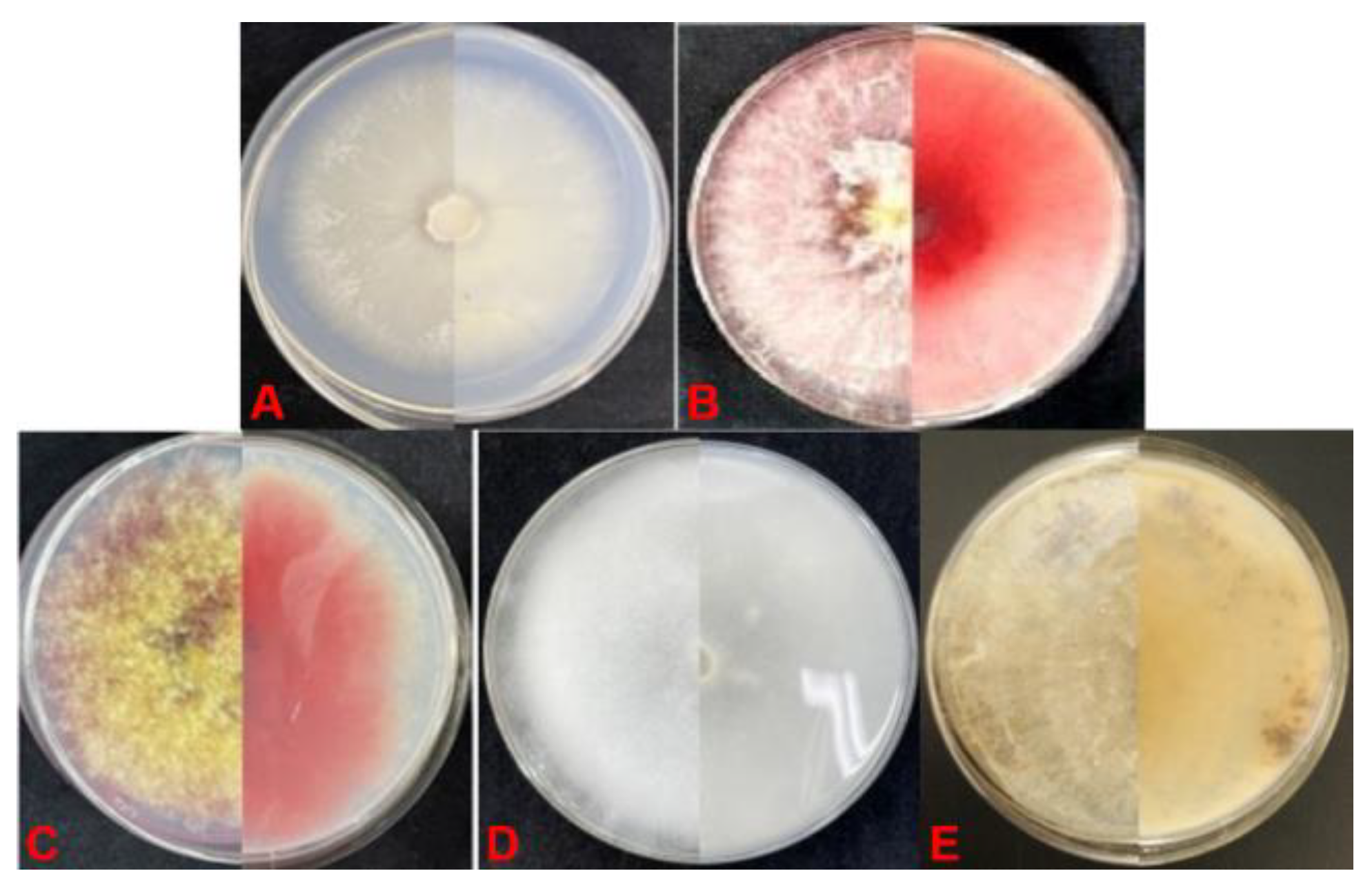
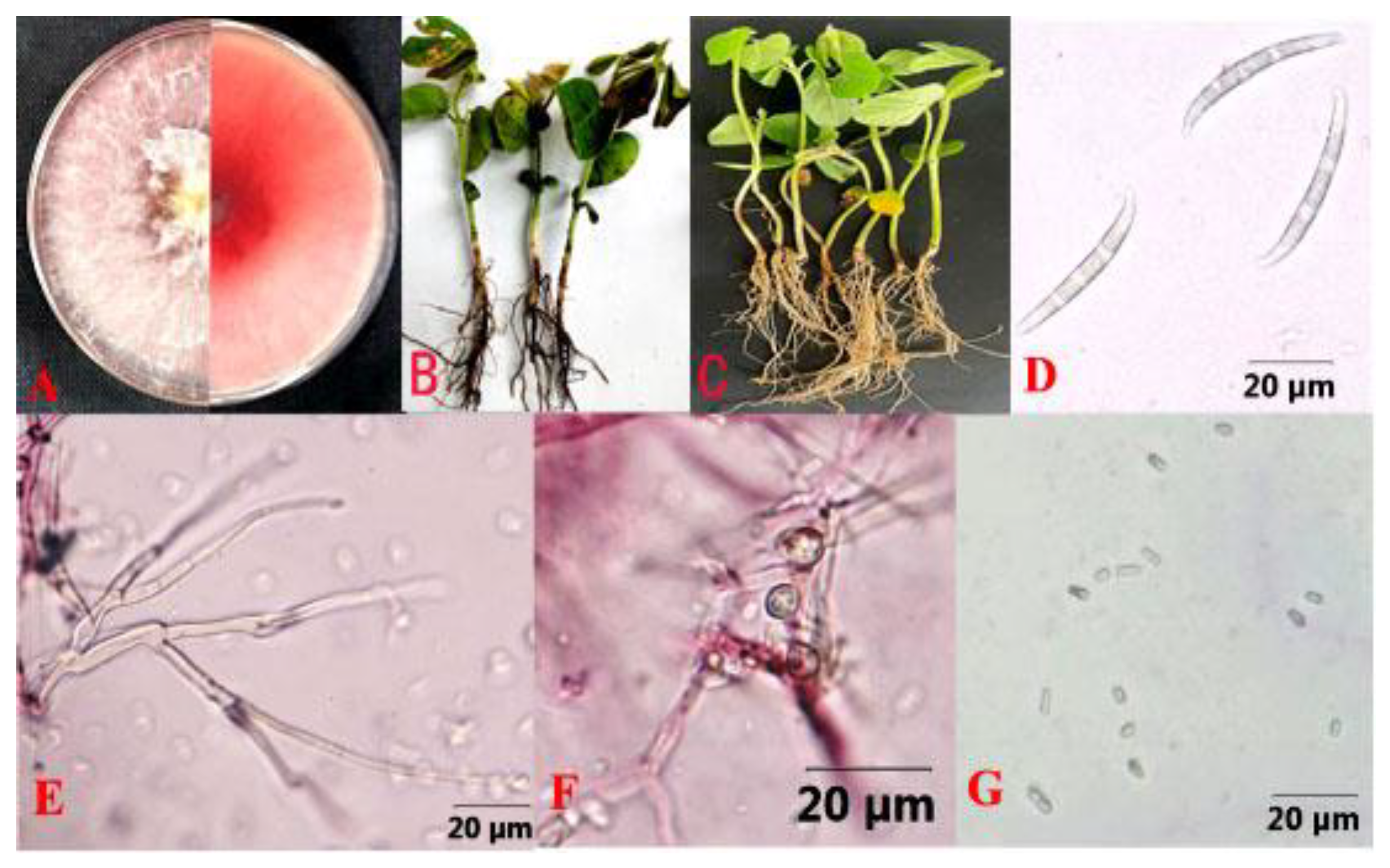
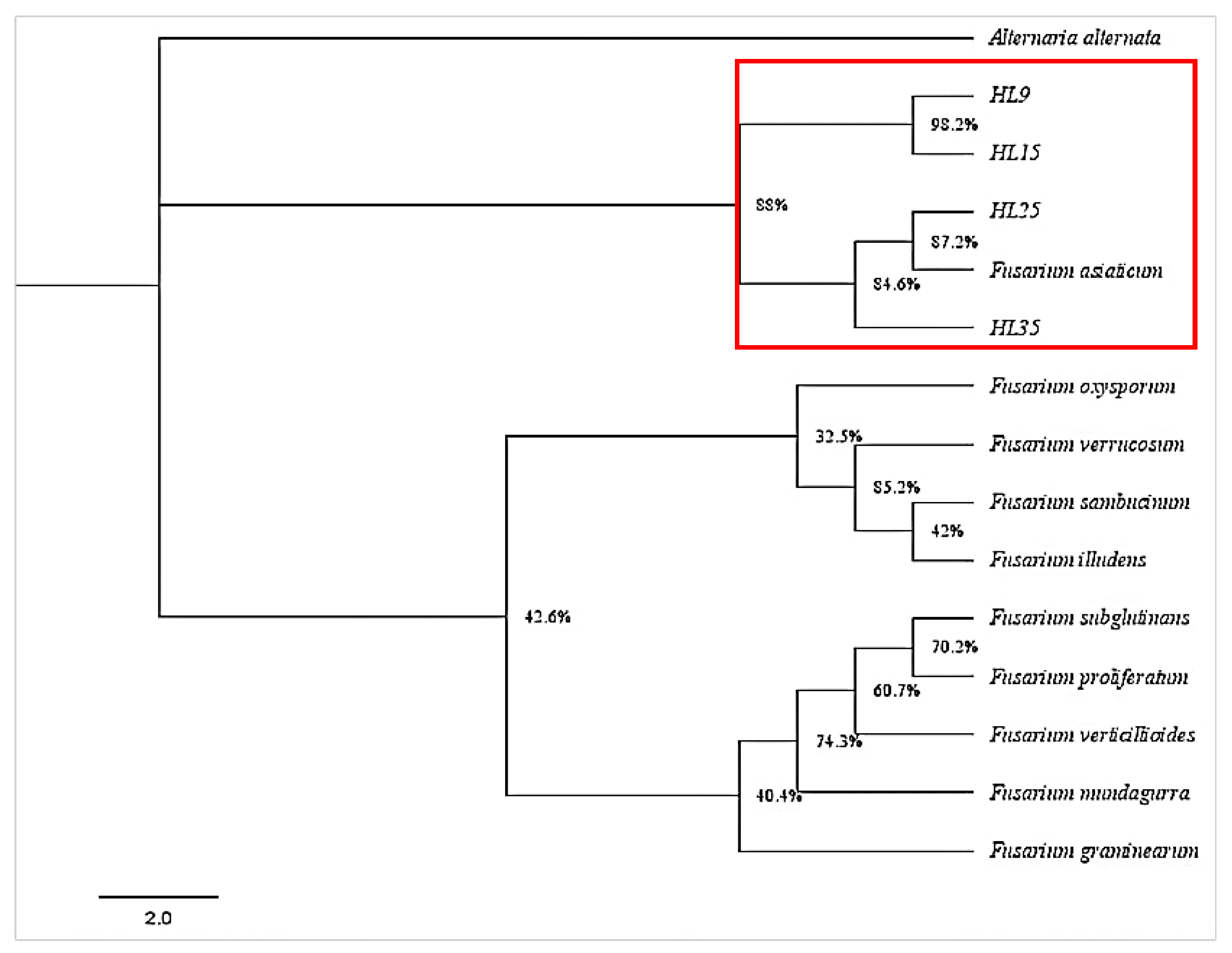

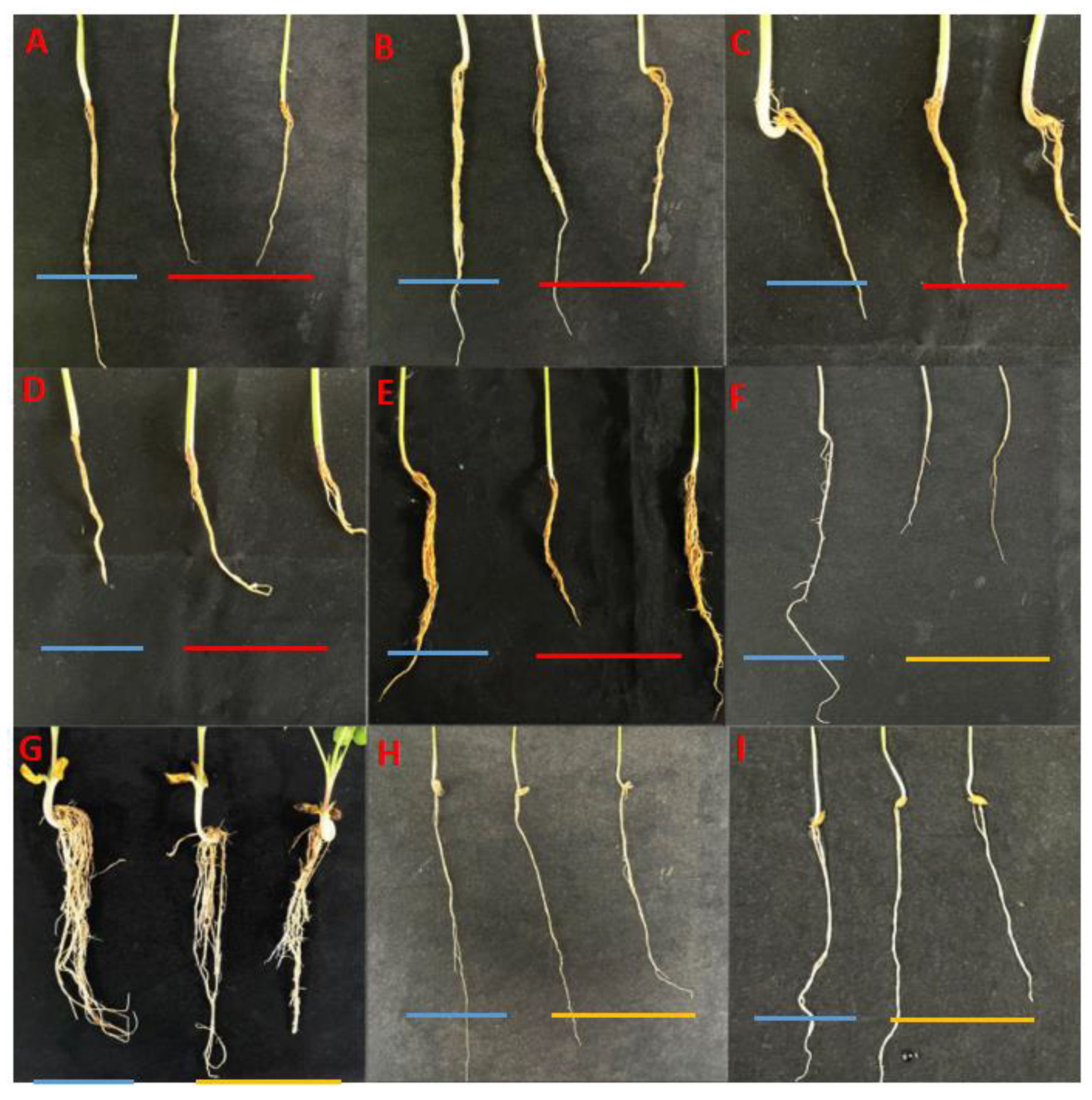
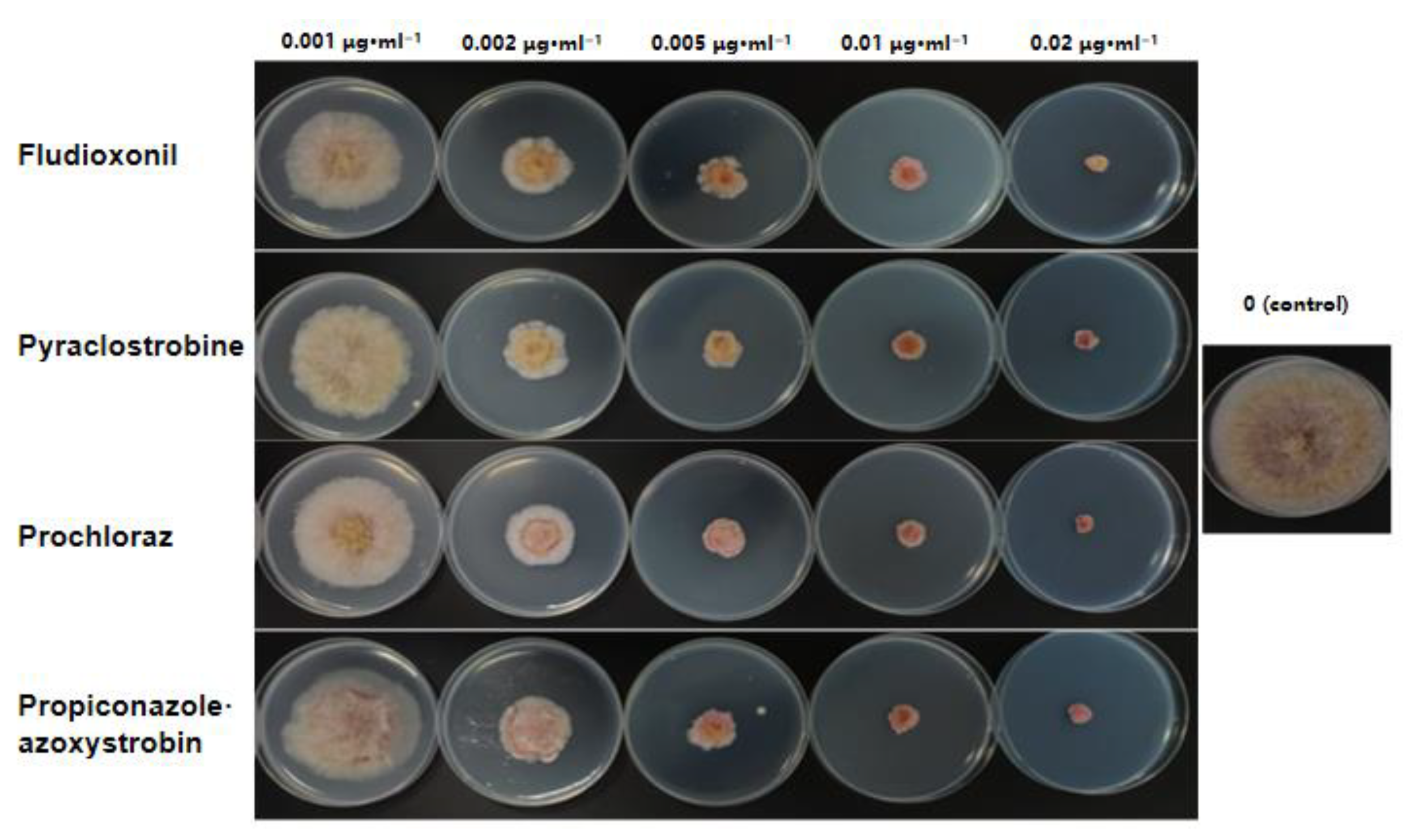
| Pathogens | Number of Isolates | Frequency (%) |
|---|---|---|
| Fusarium oxysporum | 36 | 39.1 |
| F. asiaticum | 28 | 30.4 |
| F. graminearum | 12 | 13.0 |
| Pythium spp. | 8 | 8.7 |
| Rhizoctonia solani | 8 | 8.7 |
| No. | Isolates | Disease Index | Pathogenicity 1 | No. | Isolates | Disease Index | Pathogenicity 1 |
|---|---|---|---|---|---|---|---|
| 1 | HL7 | 51.4 | M | 15 | HL40 | 27.1 | W |
| 2 | HL9 | 27.1 | W | 16 | HL42 | 47.1 | W |
| 3 | HL12 | 54.3 | M | 17 | HL43 | 58.6 | M |
| 4 | HL15 | 62.9 | H | 18 | HL45 | 57.1 | M |
| 5 | HL18 | 30.0 | W | 19 | HL48 | 31.4 | W |
| 6 | HL19 | 54.3 | M | 20 | HL51 | 48.6 | W |
| 7 | HL20 | 30.0 | W | 21 | HL55 | 65.6 | H |
| 8 | HL24 | 21.4 | W | 22 | HL56 | 54.3 | M |
| 9 | HL25 | 57.1 | M | 23 | HL58 | 47.1 | W |
| 10 | HL28 | 35.7 | W | 24 | HL59 | 51.4 | M |
| 11 | HL32 | 54.3 | M | 25 | HL62 | 31.4 | W |
| 12 | HL35 | 71.4 | H | 26 | HL66 | 45.7 | W |
| 13 | HL37 | 57.1 | M | 27 | HL73 | 62.9 | H |
| 14 | HL38 | 32.8 | W | 28 | HL81 | 42.6 | W |
| Fungicides | EC50 (μg·mL–1) | Fungal Sensitivity to Fungicides 1 |
|---|---|---|
| Fludioxonil | 0.0029–0.0071 | S |
| Pyraclostrobine | 0.0045–0.0076 | MR |
| Prochloraz | 0.0059–0.0126 | MR |
| Propiconazole·azoxystrobin | 0.0101–0.0187 | R |
| Fungicide | Effective Dose (μg·mL−1) | Control Efficacy (%) 1 | Plant Height (cm) 1 | Root Length (cm) 1 | Fresh Weight (g) 1 |
|---|---|---|---|---|---|
| fludioxonil | 250 | 73.8 ± 2.2 a | 33.4 ± 0.6 a | 12.2 ± 0.6 a | 8.0 ± 0.1 a |
| 125 | 55.6 ± 1.7 b | 27.3 ± 0.4 b | 9.6 ± 0.2 b | 6.7 ± 0.1 b | |
| 62.5 | 23.8 ± 2.5 c | 11.4 ± 0.4 c | 7.3 ± 0.4 c | 5.3 ± 0.4 c | |
| 2 Control | - | - | 3.9 ± 0.2 d | 4.3 ± 0.3 d | 3.6 ± 0.2 d |
| pyraclostrobin | 250 | 69.4 ± 1.7 a | 25.8 ± 0.93 a | 10.4 ± 0.3 a | 7.6 ± 0.2 a |
| 125 | 43.1 ± 5.4 b | 21.6 ± 0.95 b | 7.8 ± 0.2 a | 6.5 ± 0.2 b | |
| 62.5 | 18.8 ± 2.2 c | 7.9 ± 0.12 c | 6.4 ± 0.6 b | 4.2 ± 0.1 c | |
| 2 Control | - | - | 3.9 ± 0.2d | 4.3 ± 0.3 c | 3.6 ± 0.1d |
Disclaimer/Publisher’s Note: The statements, opinions and data contained in all publications are solely those of the individual author(s) and contributor(s) and not of MDPI and/or the editor(s). MDPI and/or the editor(s) disclaim responsibility for any injury to people or property resulting from any ideas, methods, instructions or products referred to in the content. |
© 2025 by the authors. Licensee MDPI, Basel, Switzerland. This article is an open access article distributed under the terms and conditions of the Creative Commons Attribution (CC BY) license (https://creativecommons.org/licenses/by/4.0/).
Share and Cite
Liu, J.; Cui, W.; Zhao, Q.; Ren, Z.; Li, L.; Li, Y.; Sun, L.; Ding, J. Identification, Characterization, and Chemical Management of Fusarium asiaticum Causing Soybean Root Rot in Northeast China. Agronomy 2025, 15, 388. https://doi.org/10.3390/agronomy15020388
Liu J, Cui W, Zhao Q, Ren Z, Li L, Li Y, Sun L, Ding J. Identification, Characterization, and Chemical Management of Fusarium asiaticum Causing Soybean Root Rot in Northeast China. Agronomy. 2025; 15(2):388. https://doi.org/10.3390/agronomy15020388
Chicago/Turabian StyleLiu, Jinxin, Wanqiu Cui, Qingyi Zhao, Zhipeng Ren, Lin Li, Yonggang Li, Lei Sun, and Junjie Ding. 2025. "Identification, Characterization, and Chemical Management of Fusarium asiaticum Causing Soybean Root Rot in Northeast China" Agronomy 15, no. 2: 388. https://doi.org/10.3390/agronomy15020388
APA StyleLiu, J., Cui, W., Zhao, Q., Ren, Z., Li, L., Li, Y., Sun, L., & Ding, J. (2025). Identification, Characterization, and Chemical Management of Fusarium asiaticum Causing Soybean Root Rot in Northeast China. Agronomy, 15(2), 388. https://doi.org/10.3390/agronomy15020388






